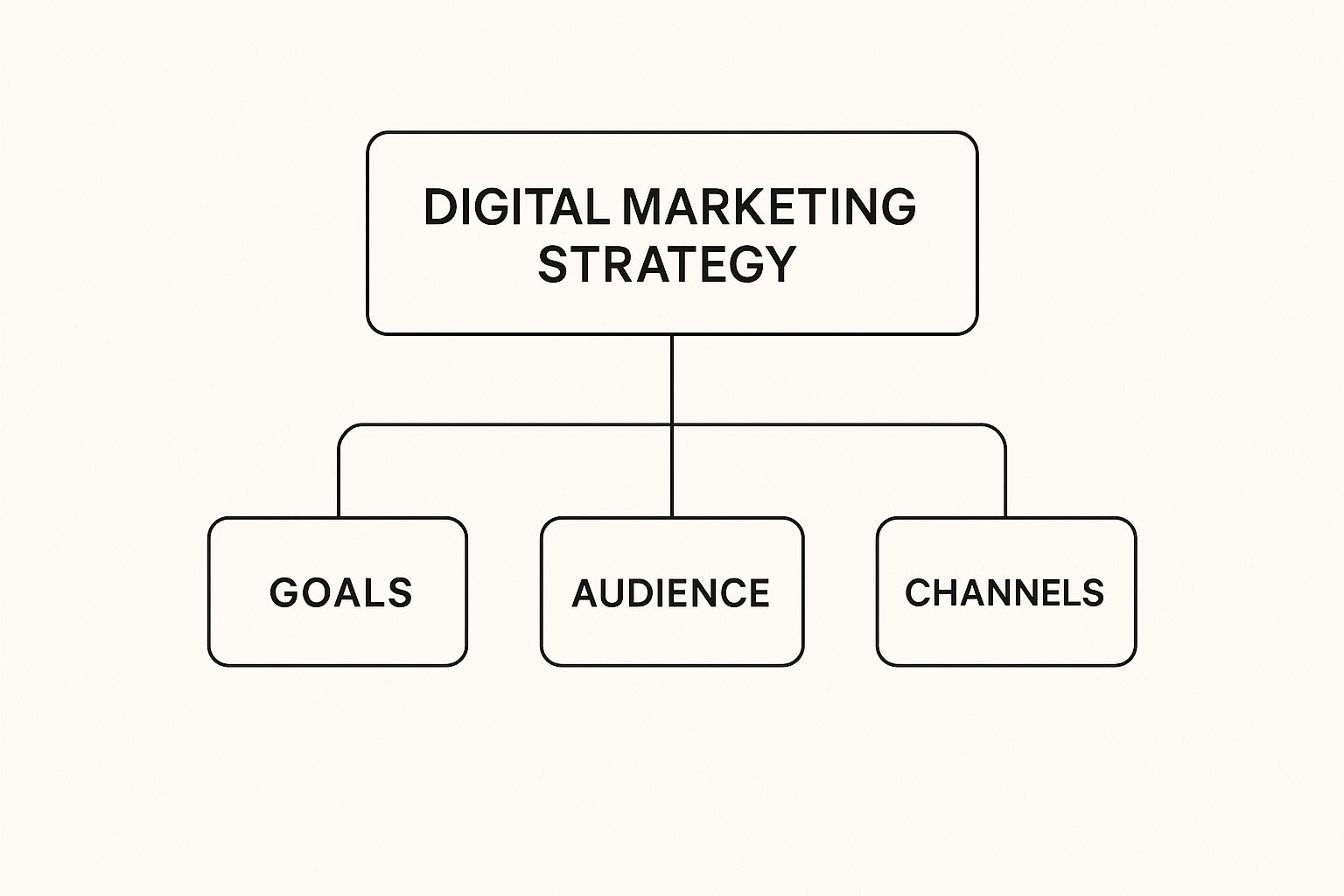A solid sample digital marketing strategy isn't a dusty, 100-page document you create once and forget about. Think of it as a living roadmap for your business—one that connects your most important goals to your day-to-day actions. It's the blueprint that ensures every blog post, every ad, and every dollar spent has a clear purpose.
Your Digital Marketing Strategy Blueprint
Staring at a blank page when planning your marketing can feel intimidating. Where do you begin? The key is to break the process down into manageable pieces. An effective digital marketing strategy is built on a handful of core pillars that work together to attract, engage, and win over your ideal customers. It’s less about doing everything and more about doing the right things consistently.
This structured approach prevents you from just throwing tactics at the wall to see what sticks. Instead of randomly posting on social media or running ads without a clear objective, every action is tied back to a specific goal. This clarity not only delivers better results but also makes it far easier to justify your budget and prove your marketing's value.
The Five Core Pillars of Growth
At its heart, a great plan answers five fundamental questions. These pillars support your entire marketing operation. Get these right, and you're well on your way to building a predictable growth engine for your business.
- Setting Clear Goals: What does success actually look like? This requires getting more specific than just "more leads." A meaningful goal sounds like: "Increase marketing qualified leads by 25% over the next six months." The difference is that it's specific and measurable.
- Understanding Your Audience: Who are you trying to reach? This is where you create detailed buyer personas to understand their biggest frustrations, motivations, and where they spend their time online.
- Choosing the Right Channels: Where will you show up? Based on your audience insights, you'll select the platforms where you can make the biggest impact—whether that's through SEO, paid ads, or email marketing. You don't have to be everywhere.
- Creating Valuable Content: What will you say to them? This is about developing content that genuinely helps your audience solve their problems. Doing so builds trust and positions your brand as the go-to authority.
- Measuring What Matters: How will you know if it's working? This involves focusing on Key Performance Indicators (KPIs) that reflect business growth, not just vanity metrics that look good on paper.
This diagram breaks down how these essential pillars—Goals, Audience, and Channels—create the foundational structure of any robust digital marketing strategy.

This visual illustrates that every strategic decision should flow directly from these core components, creating a plan that is not just clear, but logical. To get a better sense of the mechanics behind all this, you can learn more about how digital marketing works in our detailed guide.
To bring it all together, here’s a quick overview of how these pillars form the foundation of a winning strategy.
Core Pillars of a Winning Digital Marketing Strategy
Nailing these five areas is what separates a plan that gathers dust from one that actively drives results.
A great strategy provides the "why" behind every marketing action. It ensures you're not just busy, but productive, focusing your resources on activities that directly contribute to business growth and long-term success.
Setting Goals That Actually Drive Growth

Think of your digital marketing strategy like a high-performance car. It’s powerful and capable, but without a destination plugged into the GPS, you’re just burning fuel. Vague goals like "get more leads" or "boost brand awareness" are the equivalent of deciding to "drive north"—you’re moving, but you have no idea if you're getting closer to where you want to be.
To achieve real results, you must define what winning looks like in concrete, measurable terms. This critical first step replaces wishful thinking with a strategic plan, setting the foundation for every decision you’ll make moving forward.
The SMART Framework for Marketing Goals
The most reliable way to set meaningful objectives is the SMART goal framework. It's a simple yet effective filter that sharpens fuzzy ideas into actionable targets. Every major goal in your strategy should be Specific, Measurable, Achievable, Relevant, and Time-bound.
Let's see how this works in a practical scenario. Imagine a B2B company wants to ramp up its lead generation.
- Vague Goal: "Get more leads from our website."
- SMART Goal: "Increase the number of marketing qualified leads (MQLs) generated from organic search traffic by 25% over the next fiscal quarter (Q3)."
The difference is stark. The second goal gives the team complete clarity. They know exactly what to do (focus on MQLs from organic search), how success will be measured (25% growth), and the deadline (end of Q3).
Setting SMART goals transforms your marketing from a random list of tasks into a focused, cohesive campaign. It provides the "why" behind every blog post, ad, and email, making sure every ounce of effort is pushing toward the same finish line.
Connecting Goals to Key Performance Indicators
Once you've set your big-picture goals, you need a way to track your progress in real time. This is where Key Performance Indicators (KPIs) come into play. If your SMART goal is the destination, your KPIs are the gauges on your dashboard—telling you if you're on the right track.
KPIs are the specific metrics you’ll monitor to check the health of your strategy. They provide the hard evidence that your actions are working. For our SMART goal of increasing MQLs, the right KPIs would offer a direct line of sight into our performance.
Example KPIs for the MQL Goal:
- Organic Search Traffic: How many people are finding us through search engines?
- Keyword Rankings: Where do we rank for the terms our ideal customers are searching for?
- Conversion Rate (Lead Magnet): What percentage of visitors download our ebook and become a lead?
- Cost Per Acquisition (CPA): How much are we spending to acquire each new customer? This signals marketing efficiency.
Choosing the right KPIs is crucial. It’s easy to get distracted by vanity metrics like social media likes or total website visits, which feel good but don’t always translate to business results. Instead, select metrics with a direct, undeniable link to your main business objective, whether that’s revenue growth or customer acquisition.
From Metrics to Growth Engine
When you link specific KPIs to your overarching SMART goals, you create a powerful feedback loop. You can see which channels are pulling their weight, what content is resonating, and where to allocate your budget for the greatest impact. This data-driven approach is what separates a marketing department that costs money from one that predictably generates revenue.
For instance, tracking your CPA helps you see the direct financial return of your campaigns. If your CPA is dropping while your MQLs are climbing, you know your strategy is becoming more efficient. That’s the kind of insight that’s invaluable, especially when running paid ads. If you want to dig deeper, our guide on how to calculate return on ad spend breaks it down so you can prove the value of every dollar.
This process builds the dashboard that steers your entire strategy, turning abstract goals into a clear, actionable plan for growth.
How to Truly Understand Your Audience

You’ve locked in your goals. Now comes the part that separates campaigns that fizzle out from those that catch fire. This next pillar of your sample digital marketing strategy is arguably the most important.
If you try to market to everyone, you’ll connect with no one. Real marketing power comes from a deep, personal understanding of the people you’re trying to reach. This is where you ditch vague assumptions and start painting a crystal-clear picture of your ideal customer. It’s not just about their age or job title—it’s about getting inside their world to see what makes them tick.
Moving Beyond Demographics to Buyer Personas
The best tool for this job is the buyer persona. Think of a persona as a semi-fictional character that represents your ideal customer. Give them a name, a job, real-world goals, and—most importantly—challenges that your business can solve.
Creating these personas is like being a detective. You gather clues from the real world and piece them together into a story. This "character" then becomes your north star for every marketing decision, from the copy on your website to the ad platforms you invest in.
A well-crafted buyer persona is like a compass for your marketing team. When you’re not sure which direction to go, you can simply ask, "What would our persona, 'Marketing Mary,' think of this?" It keeps your entire strategy focused and customer-centric.
To build a useful persona, you need to pull information from multiple sources. Relying on a single data point will give you a skewed view. You need a blend of quantitative data and qualitative stories.
- Customer Surveys: Just ask! Send a survey to your current customers about their goals, their biggest headaches, and how they found you. Tools like SurveyMonkey or a simple Google Form can unearth invaluable insights.
- Sales Team Feedback: Your sales team is on the front lines every day. They know the common objections, the burning questions, and the "aha!" moments that close a deal. That's pure intelligence you can't get anywhere else.
- Social Media Analytics: Platforms like LinkedIn and X (formerly Twitter) are treasure troves of data. See what topics your audience engages with, what questions they’re asking, and who they follow in their industry.
- Website Analytics: Dive into Google Analytics to see how people behave on your site. Which blog posts get the most attention? What search terms are bringing them to you? This data is a direct window into their interests.
This foundational work is what makes a persona feel real and actionable. For a deeper dive, check out our complete guide on how to create buyer personas that actually work.
Uncovering Psychographics: The 'Why' Behind the Buy
Once you have that foundational data, it’s time to dig into psychographics. Demographics tell you who your customer is. Psychographics tell you why they buy. This is where you uncover the emotional triggers that make your marketing truly connect.
Get inside their head by focusing on these key elements:
- Pain Points: What keeps them up at night? Is it an inefficient process? Pressure from their boss to prove ROI? A B2B buyer is almost always trying to solve a problem.
- Motivations: What are they running toward? A promotion? Recognition from leadership? The satisfaction of making their team more successful? When you understand their ambitions, you can position your solution as the key to their success.
- Watering Holes: Where do they go online to get smarter? Are there specific podcasts they follow, industry blogs they read, or LinkedIn groups they participate in? This tells you exactly where you need to be.
When you map these details, your messaging shifts dramatically. Instead of listing features, you can speak directly to how your product alleviates their frustrations and helps them achieve their career goals. It’s the difference between saying "Our software has X feature" and "Our software helps you get that promotion."
This is the hallmark of a mature marketing strategy. Your persona isn't just a document—it's the secret to making your brand feel essential.
Choosing Your Most Powerful Marketing Channels

Now that you’ve set your goals and have a clear picture of your ideal customer, it’s time to decide where you’ll show up. A core part of any sample digital marketing strategy is choosing the right platforms to build your presence—not trying to shout from every single rooftop.
The goal isn't to be everywhere at once. That's a surefire way to spread your budget and team too thin. The secret is to be strategically present where your audience is already looking for the solutions you provide.
The Big Four Core Channels
While there are dozens of platforms, most successful strategies are built on a foundation of a few core channels. These are the workhorses of digital marketing, each with distinct strengths. Your job is to pick the combination that makes the most sense for your business goals and the habits of your buyer personas.
Here are the primary channels to consider:
- Search Engine Optimization (SEO): This is the long game. SEO is about optimizing your website and content to rank high in search engine results for keywords your customers use every day. When someone searches for a solution, you want to be the first answer they find.
- Content Marketing: This is the fuel for almost every other channel. By creating valuable, relevant, and consistent content—like blog posts, videos, or guides—you attract and retain a specific audience. It’s how you build trust and establish authority.
- Paid Advertising (PPC): Need results and visibility now? Paid ads are your accelerator. Platforms like Google Ads and social media advertising let you target specific demographics and behaviors with precision, putting your message directly in front of a qualified audience.
- Email Marketing: This is your direct line of communication. Email lets you build and nurture relationships with leads and customers, delivering value straight to their inbox. It remains one of the most effective ways to drive conversions and foster loyalty.
Aligning Channels with Your Goals and Audience
The right channels for a B2B software company will look completely different from those for a local e-commerce brand. Your buyer personas and SMART goals are the compass that guides this decision.
For example, if your persona "Marketing Mary" spends her day on LinkedIn and reads industry blogs, then a strategy built around LinkedIn Ads and authoritative SEO content is a no-brainer. Trying to grab her attention with TikTok videos would likely be a waste of resources. This is where your upfront research pays off.
The global digital marketing industry continues to expand, and content marketing is a key pillar of that growth. The market is projected to reach $472.5 billion by 2025, with quality content as a primary driver. In fact, 84% of B2B marketers use content marketing to build brand awareness, and 76% rely on blogs as their main distribution channel, highlighting the power of creating valuable content on the right platforms.
Building an Integrated Channel Ecosystem
The most powerful strategies don't treat these channels as separate islands. They create an integrated ecosystem where each channel supports and amplifies the others. This creates a multiplier effect, where the whole becomes far greater than the sum of its parts.
Think of it as a well-oiled machine:
- You publish a detailed, helpful blog post (Content Marketing).
- You optimize that post to rank for important search terms (SEO).
- Then, you run paid ads on social media to drive initial traffic and buzz (PPC).
- Visitors can sign up for your newsletter, where you nurture them with more great content (Email Marketing).
This approach creates a seamless journey for your customer, ensuring you capture attention from all angles. If you're weighing the pros and cons of these different approaches, our guide comparing paid search vs organic search offers a much deeper breakdown.
An integrated strategy means your channels work in concert. Paid ads can validate which content topics resonate most, giving you valuable data to inform your long-term SEO and content strategy. This synergy turns your marketing into an intelligent, self-optimizing system.
Choosing the right marketing channels can feel overwhelming, but it doesn't have to be. Start with your audience and your goals. This table breaks down the primary channels to help you see which ones might be the best fit for your business.
Digital Marketing Channel Selection Guide
Ultimately, your channel mix will be unique to your brand. Use this guide as a starting point, but don't be afraid to test, measure, and pivot. The best marketers are always learning what works for their specific audience and adjusting their strategy accordingly.
Building a Content and Distribution Engine
Once your goals, audience, and channels are defined, it's time to build the engine that drives everything. Think of content as the fuel. Without it, your SEO has nothing to rank, your social media accounts go silent, and your emails have nothing to say.
In this piece of our sample digital marketing strategy, we'll build a practical system for creating content that consistently hooks your ideal customers. But creating great content isn’t enough. We'll also cover smart distribution to ensure your hard work gets seen.
Brainstorming Content That Solves Problems
The best content ideas don't come from a whiteboard session about what you want to talk about. They come directly from the problems your buyer personas face every day. Stop thinking like a content creator and start thinking like a problem-solver.
Every article, video, or guide you create should answer a burning question, soothe a pain point, or help your audience achieve a goal. This is how you build trust and become the go-to resource in your industry.
To keep ideas flowing, return to your persona research:
- Pain Points: Does your persona struggle with proving marketing ROI? A topic like, "5 Simple KPIs to Demonstrate Marketing's Value," will resonate.
- Motivations: Are they driven by career growth? Content like, "How to Build a Killer Business Case for That New Marketing Tool," speaks directly to their ambition.
- Common Questions: Listen to your sales team. If they're constantly asked how you compare to a competitor, an honest comparison post could become a valuable asset.
When you ground your content in your audience's reality, you guarantee its value. To dig deeper into this mindset, check out these content marketing best practices that focus on creating audience-first material.
From Ideas to a Content Calendar
With a list of solid ideas, you need a plan to bring them to life. A content calendar is your roadmap. It saves you from last-minute scrambles and ensures you're publishing a steady stream of helpful content.
It doesn't need to be complicated software; a simple spreadsheet often works perfectly.
Your content calendar turns strategy into an actionable plan. It forces you to think ahead, assign resources, and maintain a balanced mix of topics and formats that guide people through their entire journey with you.
At a minimum, your calendar should track the essentials for each piece: topic, format (blog, video, etc.), target persona, main keyword, and the publish date. This simple structure brings clarity to the process and keeps everyone on the same page.
Amplifying Your Content Through Smart Distribution
Creating a masterpiece of a blog post means nothing if it just sits on your website collecting dust. Distribution is how you get your message in front of the people you’ve worked so hard to understand. It’s where you take your content and actively push it across your chosen channels.
Your content is the star of the show. Your distribution channels are the stage and the promotion. You need a multi-channel approach to maximize your reach.
Key Distribution Tactics:
- Email Marketing: Your email list is a valuable asset. Share your latest content with subscribers—they’re already engaged and can help kickstart traffic and social shares.
- Social Media: Post your content across your chosen platforms, but tailor the message for each. A professional insight works for LinkedIn, while a punchy stat might be better for X.
- Paid Amplification: Put a small ad budget behind your top-performing content. It's an effective way to reach a wider, highly targeted audience and accelerate lead generation from an asset you already know works.
The digital world is more visual and interactive than ever. Video remains a dominant force, with an estimated 87.5% of adults watching short-form videos weekly. With over 65% of the global population on social media, marketers must lean into AI-driven personalization and compelling video to stand out. A dynamic distribution plan is essential.
Measuring Performance and Optimizing Your Plan
A strategy without measurement is just a guess. You’ve done the hard work of setting goals, defining your audience, and picking your channels. Now it’s time to build the feedback loop that turns your plan from a static document into a dynamic growth engine.
This is about tracking what works, ditching what doesn’t, and making smart decisions based on real data.
Your marketing plan is the map for a long voyage, and your analytics are your instruments—the compass, GPS, and weather radar. You wouldn't sail blind, and you shouldn't market blind. Tools like Google Analytics 4 are non-negotiable for understanding how people find you and what they do once they arrive.
This final piece transforms your plan from a one-time project into a cycle of continuous improvement. It’s how you find what resonates and double down on it for long-term, sustainable growth.
Establishing a Rhythm for Review
Consistency is crucial. You don't need to obsess over every metric daily, but setting a regular time to review your data is critical. This prevents you from making knee-jerk reactions to small fluctuations while ensuring you catch important trends.
A simple and effective rhythm is to schedule monthly or quarterly reviews. This gives your campaigns enough time to collect meaningful data, so you can spot real patterns instead of just noise.
- Monthly Check-ins: These are for tactical tweaks. Are your ads hitting their cost-per-click targets? Is your email open rate holding steady?
- Quarterly Reviews: This is where you zoom out to look at the big picture. Are you on track to hit your main SMART goals? Is one channel outperforming the others?
A structured review process turns raw data into powerful insights. It's the moment you step back from the daily grind to ask the most important question: "Is this actually working?"
Focusing on Metrics That Matter
When you sit down for these reviews, it's easy to get lost in a sea of data. The key is to zero in on the Key Performance Indicators (KPIs) that tie directly back to your business goals.
For example, influencer partnerships are a huge part of many strategies. In fact, 59% of marketers plan to increase their influencer collaborations. To measure the real impact, you must look past vanity metrics like likes and shares.
Social content heavily influences buying decisions, with 76% of global users saying it impacts what they buy—a number that skyrockets to 90% for Gen Z. Instead of just tracking engagement, measure things like referral traffic from social channels or conversion rates from influencer-specific discount codes. These are the numbers that show if the investment is paying off.
You can find more trends like these in our roundup of 2025 digital marketing statistics and insights.
Optimizing Through A/B Testing
Once you know what’s working, you can make it even better. A/B testing, or split testing, is a straightforward but incredibly powerful way to optimize your campaigns.
The concept is simple: you create two versions of something—like an email subject line or a landing page headline. Then you show version A to one part of your audience and version B to another, and you see which one performs better.
This data-driven approach removes guesswork from your decisions. Instead of a team debating which headline sounds better, you let your audience's behavior show you what actually works better. It’s how you make small, incremental improvements that compound into massive gains over time.
Still Have a Few Questions?
Even with a solid template, a few questions always pop up when you're ready to put a strategy into action. Let's clear up some of the most common ones so you can move forward with confidence.
How Often Should I Actually Update My Marketing Strategy?
Think of your strategy as a living document, not something you write once and file away. You’ll want to monitor your Key Performance Indicators (KPIs) monthly for small tweaks and course corrections.
Then, once a quarter, take a bigger step back. This is your chance to dig into how each channel is performing and assess if you’re on track to hit your main goals. A major, top-to-bottom overhaul should be planned about once a year, or anytime there's a significant shift in your business, the market, or customer behavior.
What's The Single Most Important Part Of A Digital Marketing Strategy?
If you have to nail one thing, make it a deep, almost obsessive understanding of your target audience. Every other piece of the puzzle—from the social media platforms you use to the blog posts you write—is built on the foundation of your buyer personas.
Without a crystal-clear picture of who you're talking to and what they care about, the rest of your marketing efforts will feel generic and fall flat.
A great plan isn't just about what you do; it's about who you're doing it for. When your audience is at the core of your strategy, your marketing resonates on a much deeper level, building trust and driving action.
How Can I Create A Strategy If My Budget Is Tiny?
A small budget means you have to be scrappy and smart. Your best bet is to lean into high-impact organic channels first. This means prioritizing things like creating genuinely helpful blog content, optimizing your website for search engines (SEO), and building a community on one or two social platforms where your audience actually spends their time.
Don't forget email marketing—it's incredibly cost-effective for nurturing the audience you build. The key is to start small, measure everything, and then reinvest any profits back into the channels that are proven to work. Once you have momentum, you can begin exploring paid ads.
Ready to build a strategy that goes beyond a sample template and truly drives growth? The team at Twelverays lives and breathes data-driven marketing and CRM solutions that deliver results you can actually measure. Let's work together to build the roadmap for your success. Start the conversation with Twelverays today.





